Since living in Costa Rica for the past 10+ years, we have visited several wildlife sanctuaries and rehabilitation centers. These important organizations help animals that have been injured in the wild, orphaned, or held illegally as pets. The experience visiting these places can differ a lot. One of our favorites is the Jaguar Rescue Center in Puerto Viejo de Talamanca. We have been a couple of times, and on each visit, we leave inspired to help Costa Rica’s amazing wildlife. In this post, we’ll share what the Jaguar Rescue Center tour is like.
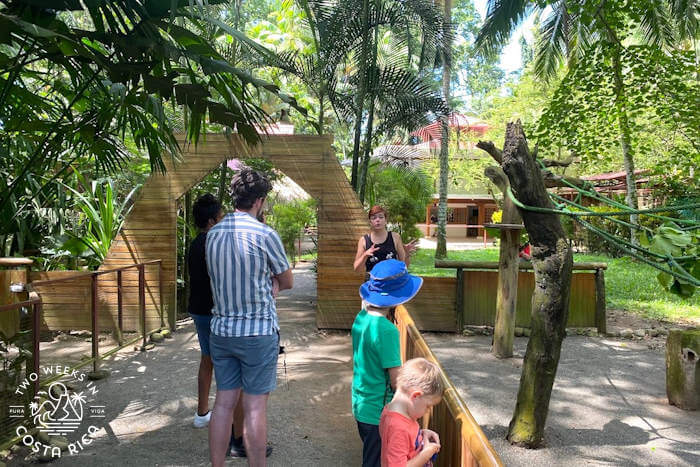
Background
Founding
The Jaguar Rescue Center was founded by Sandro Alviani and Encar Garcia, an Italian-Spanish couple living in Puerto Viejo. Sandro had a background in herpetology, researching reptiles and amphibians, while Encar was a specialist in primates who had worked at the Barcelona Zoo.
Encar had always wanted to help animals by starting a rescue center. As the couple became known in the local community, her dream quickly became true.
In 2005, locals started bringing them injured animals after hearing about the “foreigner animal experts” living in town.
The first animal was an ocelot, one of the smaller big cats in Costa Rica. The local who found the injured cat mistakenly thought it was a jaguar, hence the name Jaguar Rescue Center.
Eventually, Sandro and Encar had more animals than they could care for on their own. On their property, they built enclosures for the injured animals and eventually expanded, buying adjoining lots to increase the space of their facility.
In 2008, they officially opened as the Jaguar Rescue Center.
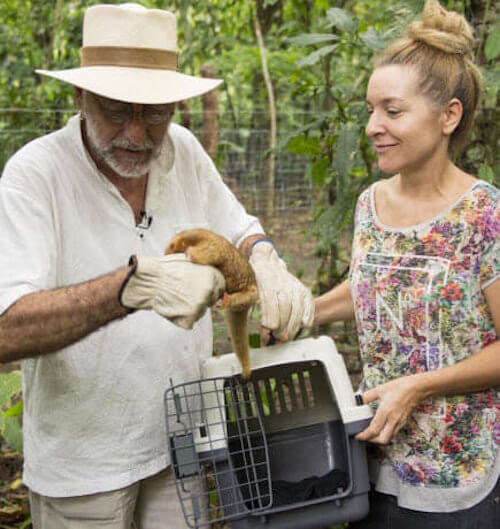
Facility Today
Over time, the facility has expanded and improved. We noticed a difference in the center from our visit in 2023 to when we first went in 2013.
Today, the Jaguar Rescue Center facility is about 22,000 square meters (5.4 acres) and can house up to around 160 animals on a temporary basis.
Rehabilitation Center, Sanctuary, and Release Site
The facility is made up of the rehabilitation center and sanctuary. They also have a release site called La Ceiba where the animals go when they are healthy and ready to go back to the jungle.
The rehab center is where their team of veterinarians and staff care for animals that hopefully will be released. Because the animals will be released, the center aims to reduce human interaction as much as possible. For this reason, visitors cannot access the rehab center.
Instead, visitors can tour the sanctuary. For some animals, reintroduction isn’t possible due to health or behavioral problems. These animals live the rest of their life in the sanctuary, where they are cared for and live in habitats similar to their natural environment.
Below, we share our experience visiting the sanctuary.
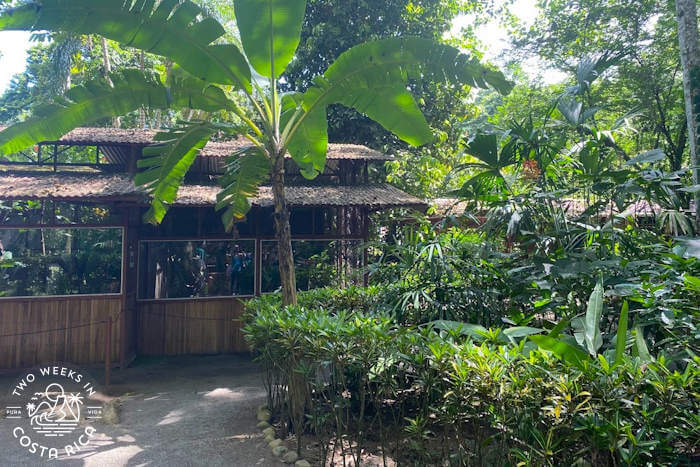
Tour
Introduction
Our tour started at the reception area of Jaguar Rescue Center where we met Lizzy. Lizzy was a young volunteer who had been working at the center for a few years. She was originally from the US but lived in Puerto Viejo.
Donning fun sloth socks and leopard print shorts, Lizzy told us right away how much she cared for animals. Her passion had brought her to the Jaguar Rescue Center.
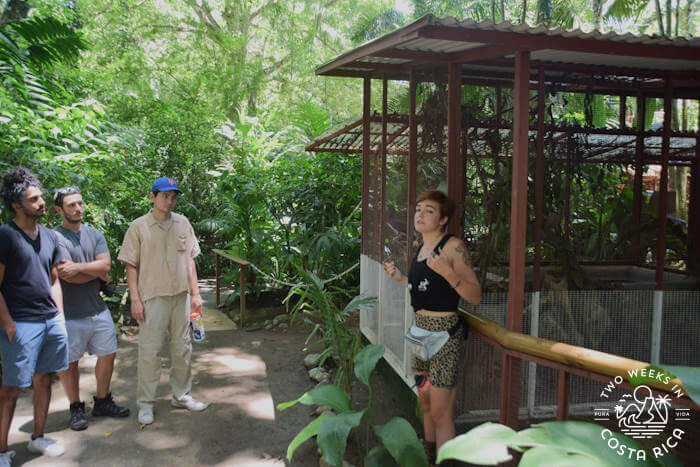
Meeting the Animals
Brown Boobies
Lizzy led the way to the first enclosure. It had sea birds called Brown Boobies.
Dado, one of the birds, had been brought in with bad wing. It healed at a strange angle. Lizzy explained that once broken, it is hard to fix bird bones. Dado can’t fly anymore so he lives at the center.
Another bird named Bobo was found on Playa Cocles with a fishing lure in its beak and more in its stomach. They were able to get Bobo healthy again but every time they tried to release him, he would beg people for food. They kept trying but it kept happening.
Peccaries
Next, we saw some peccaries. These are large animals that resemble wild boars. Most of the ones at the center had been kept as pets. This makes release very difficult because the animals have been humanized.
Sloths
The next stop was Lizzy’s favorite, the two-toed sloths.
She taught us a lot about sloths, including that, despite their cuteness, they have large canine teeth and very sharp claws. She then taught us about what they eat, how they are actually pretty active despite looking like they are sleeping all the time, and how they climb down from trees to go to the bathroom.
Sadly, some of the sloths had ended up at the center because they were electrocuted by utility lines. Lizzy explained that this is somewhat common in the area. She then went on to tell us that the Jaguar Rescue Center has a program in place to put protective transformers on local power lines to stop this from happening.
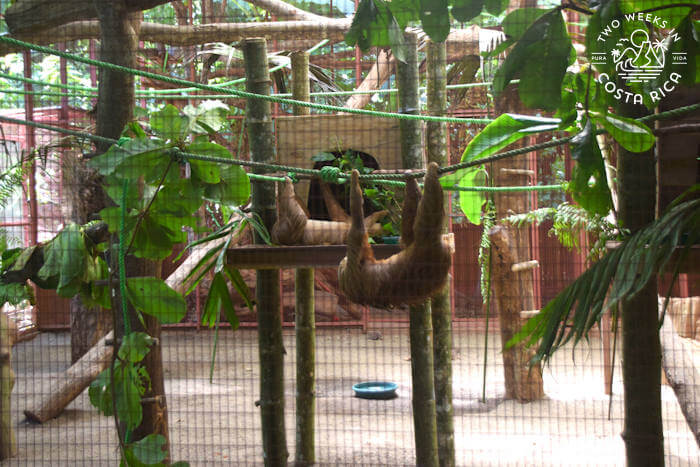
Turtles
A big pond with lots of greenery housed several Nicaraguan slider turtles. These are sometimes kept as pets then people release them once they get too big.
Caiman
One of the most memorable animals we met was a spectacled caiman named Pancha. A couple on their honeymoon had found her in the shower at their hotel! Pancha had been kept as pet then released into wild once she got too big. She came to the hotel seeking out humans.
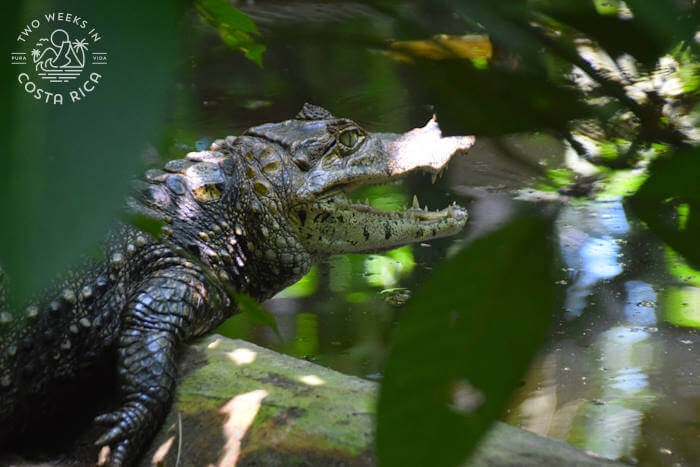
Margay
After the pond, we met one of the oldest animals at the center, a margay named Diabalino. Margays are the second smallest wild cat in Costa Rica.
Diabalino was brought in 15 years ago when the center was first started. He was found with his dead mother at the Panama border. The mother had been killed for fur. The cub was supposed to be sold. Diabalino was fed coffee and bread to make him seem more perked up for sale.
The margay was brought back to health by the Jaguar Rescue Center, but they could never successfully release him after seven attempts. He kept returning to the center.
Macaw Parrots
Next, we enjoyed some time with the chatty Scarlet and Great Green Macaws. Most of these had been kept as pets in poor conditions.
Lizzy taught us some interesting facts about these amazing birds and recommended the Ara Manzanillo to see them in the wild.
Ara Manzanillo, in the Puerto Viejo area, has a breeding program to increase the wild numbers of endangered Great Green Macaws. At that facility, you can see them flying free.
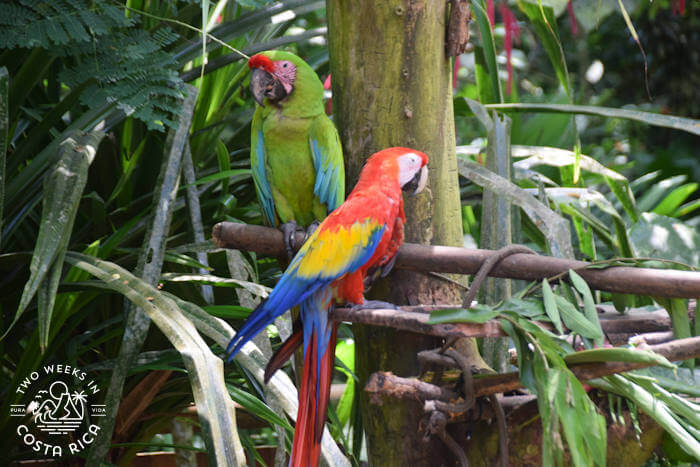
Snakes
An interesting part of the tour was learning about the fer de lances. These are probably the most dangerous snakes in Costa Rica.
The snakes at the Jaguar Rescue Center had previously been in milking facilities that make antivenom. Costa Rica is the leading producer of antivenom in the world. Apparently, when the snakes get older, they don’t produce as much and get sent to facilities like the Jaguar Rescue Center.
Baby Sloths
A highlight for just about everyone in our group were the baby sloths. They were climbing around on an open enclosure, so we were able to see them very close up.
The sloths all had various health problems, including a genetic growth disorder thought to be caused by a pesticide. Because of the genetic disorder, they can’t be released because you don’t want them to reproduce and have the problem continue.
Lizzy told us that overall, the Jaguar Rescue Center has a 98% success rate rehabilitating sloths so that was great news.
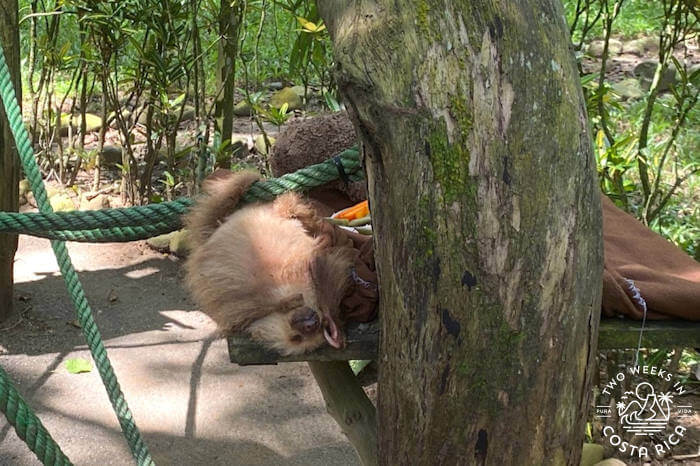
Monkeys
Another interesting part of the tour was the monkey enclosure.
First, we learned Sansa’s story. Sansa was a spider monkey that had been abandoned by her troop as a baby. She had cataracts and was going blind. Cataracts in monkeys is very rare so no one had the right equipment to help. The center ended up using a human eye doctor to perform cataract surgery. Now, Sansa has 70-80% of her vision back.
The elder spider monkey, Paco, was good friends with Sansa. Paco had been kept by humans for 27 years and severely mistreated. It took a while for them to get Paco back to acting like a monkey, but he is doing much better now. Lizzy said that Sansa and Paco love each other and that Sansa really helps Paco’s mental state.
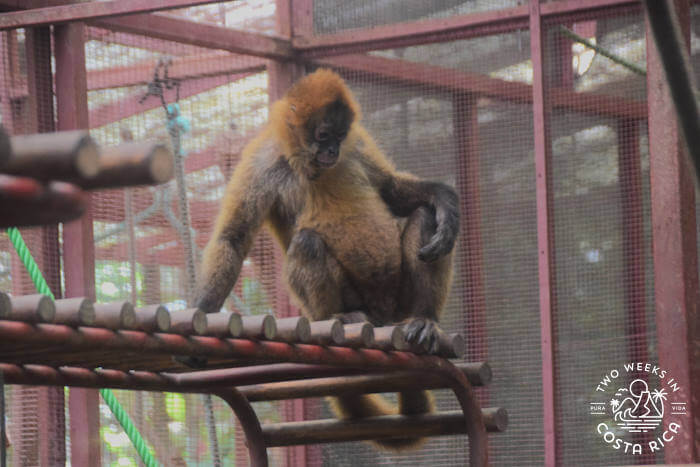
Although it was hard to hear some of the stories about the animals, it’s important to learn and raise awareness of the issues affecting Costa Rica’s wildlife. Our kids loved seeing them close up as well. Our eight-year old was entranced by each story and we all left with a feeling of wanting to help.
How You Can Help
The Jaguar Rescue Center operates on private donations and the proceeds from the center. It does not receive funding from the Costa Rican government. They have significant costs, not only to take care of the animals in the sanctuary, but also to treat the animals brought to them every day. The center gets anywhere from one to seven animals a day from the government or private parties.
You can help by taking a tour, adopting an animal, or making a donation.
They also have an Amazon Wishlist with equipment and supplies they need. You could bring some items with you on your visit.
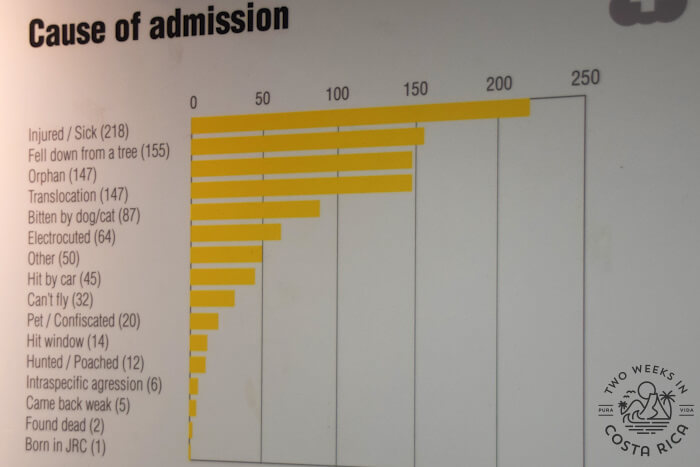
Donations also support their other conservation activities. These include:
(1) A Shock Free Zone program, where they purchase materials and work with the local electric company to insulate transformers in the southern Caribbean to reduce animal electrocutions.
(2) A rainforest protection program where they buy strategic properties in the southern Caribbean.
(3) Environmental awareness program for local schools.
(4) A wildlife monitoring program through camera traps in the Gandoca-Manzanillo area.
Planning A Visit to Jaguar Rescue Center
Tour Cost
$26.13 per person (including tax)
Costa Rican Citizens: $16.13 per person (including tax)
Kids under 10 are free
Tickets
Tickets can be purchased online through the Jaguar Rescue Center website.
We recommend buying them in advance as this is a popular tour.
You can’t visit the Jaguar Rescue Center self-guided. You have to do a tour.
Tour Times
9:30 a.m. or 11:30 a.m. Open every day.
Duration
About 1.5 hours
Accessibility
The facility is handicap accessible. They have a wheelchair if someone needs one.
Facility Amenities
The Jaguar Rescue Center is a modern facility. It has a large reception area with a café selling drinks and some food. There’s also a small gift shop.
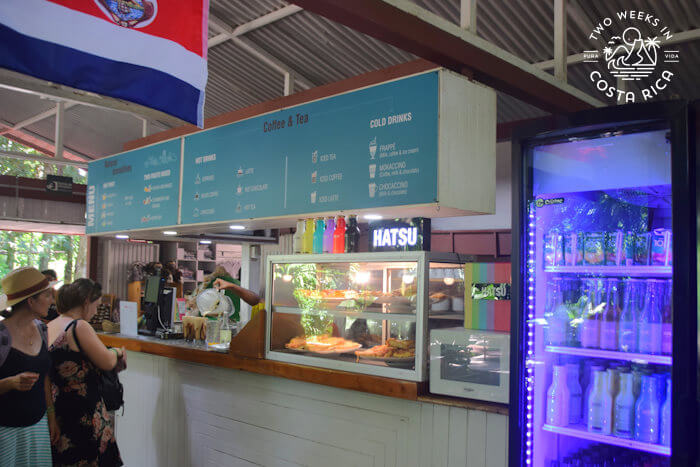
Conclusion
The Jaguar Rescue Center is a great short tour if you want to see some of Costa Rica’s amazing wildlife close up and learn about the challenges that they face. The enclosures are nicely done and you can tell that the staff at the center genuinely cares about each animal. We highly recommend it.
Have a question about the Jaguar Rescue Center or want to share your experience? Leave a comment below.
Looking for more information to plan your trip to Costa Rica? Check out these posts:
Puerto Viejo de Talamanca: Caribbean Cool in Costa Rica – Our destination guide has more ideas for activities, plus recommendations for hotels and restaurants.
Cahuita: Culture and Calm on the Caribbean – If you’re looking for a quieter town to visit on the southern Caribbean coast, Cahuita is a great option.
Rental Car Discount: Unless you’re staying in the main area of Puerto Viejo, a rental car can be nice to have for exploring the area. Check out our discount for 10% off and free extras.
